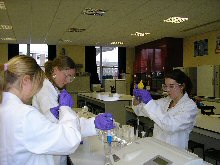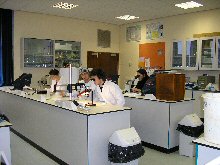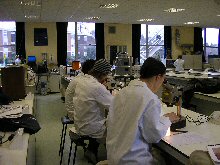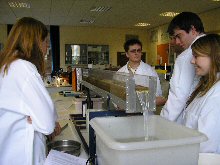|
This laboratory facility, designed and built specifically for undergraduate use, was completed in 2004. It is named after Professor H. H. Swinnerton who was the first Head of the then joint department of Geology and Geography. Up to 50 people can work in the laboratory at any time and it can also be used as a lecture room. Students use the laboratory as part of some 2nd and 3rd year modules, as well as for dissertation work.
|

|
| Facilities are available for a range of analyses of the physical and chemical properties of sediments, water and air, sample preparations for microfossil analysis (e.g. pollen and diatoms) can also be carried out. These facilities include flame photometers, a spectrophotometer, an ion chromatogram, sieves and a laser particle size analyser, freezers, furnaces and ovens. A range of light microscopes are also available for module and dissertation work. |
 |
As part of the 2nd year physical techniques course, students carry out water, air, sediment and soil analysis using a variety of analytical procedures.
The flame photometer is used to determine quantities of the metals calcium, potassium, and sodium in soil and water samples. The ion chromatogram can be used to measure both metal and non-metal ions in samples which have been suitably prepared. |
Levels of nitrogen dioxide in the atmosphere are used as an indicator of air quality. Students measure this using Palmes type diffusion tubes and measure the concentration absorbed colorimetrically with a spectrophotometer.
Using microscopes pollen grains preserved in sediment samples can be identified and past environments reconstructed. |
Particle size analysis can be carried out using sieves, or for very small particle sizes a Laser particle size analyser. The distribution of particle size provides information about how sediments were deposited although there are other applications of the technique.
Full instruction is given to anyone using apparatus for the first time (or if you need reminding)
|
 |
|
The practical element of 2nd year Desert geomorphology involves mimicking desert environmental conditions to investigate the weathering of rocks. Students try to model the effects of extreme temperature change using ovens, fridges and freezers. Exposure to varying amounts of moisture and salts are also simulated as well as the effects that these conditions have on different types of rock. The experimental procedures for this module are developed by the students and increasingly more creative methods are found to simulate desert conditions as well as report their findings!
|
 |
The 2nd year module River channel forms and dynamics practicals simulate river flow regimes and students are able to monitor changes in bedforms which they would find difficult to do in the field. The practicals are closely linked to the theory aspect of the course. A further opportunity to continue laboratory work associated with rivers is provided in the 3rd year module River Channel Management and Restoration, where students carry out their own projects. |
| All practical procedures carried out in these modules can be used to obtain results as part of the final year dissertation. Some aspects of research work carried out in the department have also been adapted for student dissertations.
|





